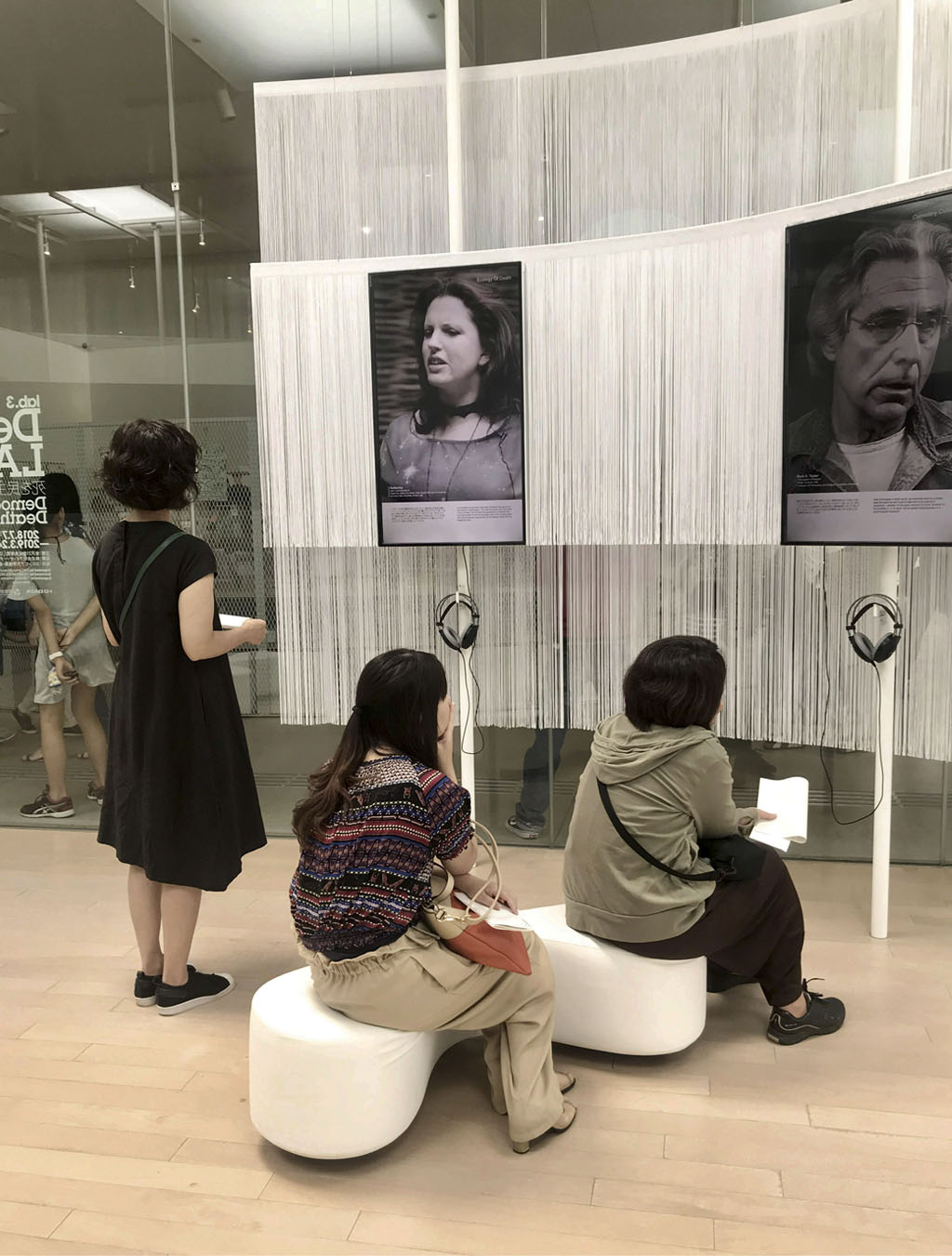27-08-19 // DEMOCRATIZING DEATH – INTERVIEW WITH KARLA ROTHSTEIN

‘Dialogue on Death’ videos at the exhibition
‘DeathLAB: Democratizing Death’
Photo by Karla Rothstein
Bernd Upmeyer interviewed Karla Rothstein, who is an architect, professor, and creative thinker living, practicing, and teaching in New York City. In both her professional work as design director at LATENT Productions and through over a decade of studios taught at the Graduate School of Architecture Planning and Preservation at Columbia University, Karla engages with alternative and emerging methods of corpse disposal in progressive proposals of civic sanctuary and temporal urban remembrance. The interview took place in August 2019.
Changes in our Society Related to Death
Bernd Upmeyer: Ever since 2013 you have been directing the so-called “DeathLAB” that you founded at the Graduate School of Architecture Planning and Preservation at Columbia University and since 2011 you have been a member of the Columbia University Seminar on Death. What were your motivations as an architect to start working and researching on topics of mortality to begin with? How did you become so interested in death?
Karla Rothstein: My interest in spaces of death and remembrance emerged out of my attention to the future of the city. Starting over a decade before the dates that you reference, I taught complementary design studios at Columbia’s GSAPP – in the Fall, several studios study the same theoretical New York City site for its potential to host multifamily housing. In the Spring, I would select both a site and a public programme for my students to engage with. I was attracted to peripheral territories, the edges and margins of NYC, where behaviours were somewhat less regulated and the potential for transformation was fertile. In that context, I encountered NYC’s vast network of existing cemetery spaces, which in aggregate occupy an area over five times the size of Central Park. It quickly became evident that the American expectation of a cemetery plot in perpetuity for each individual was at odds with both the density and spatial limits of urbanity. I also found the historic positioning and re-positioning of the cemetery compelling – going from embedded urban churchyards to exurban sites that over time the city has surrounded. Despite the current adjacencies, most cemeteries remain largely segregated from everyday life.
Initially, we accepted cremation as the solution to spatial constraints and focused on reincorporating spaces of reflection and remembrance into a more quotidian urban experience. But the practice of consuming fossil fuel to combust a corpse composed largely of water also felt misaligned with contemporary priorities, and so we began researching alternative disposition options, of which there were very few. DeathLAB grew out of both my GSAPP design studios and the work that we were doing in parallel in my architecture practice. The complexities of these issues extend beyond design, and the need to involve multiple disciplines became obvious, so we began engaging colleagues from across Columbia in dialogue on the topic. I launched DeathLAB with associates from Earth and Environmental Engineering, Philosophy/Theology, and the social sciences.
[…]
BU: Today we are witnessing many changes in our society that are related to death. Which are the most important changes in your view?
KR: Relative to twenty years ago, the degree of interest and willingness to engage in the topics of death and disposition is truly remarkable. In the U.S. and around the globe, populations are living longer. As the past issue of MONU conveyed, the numbers and differentiation among the middle aged and elderly are increasing. This reality, together with the post-WWII increase in childbirth, means that in the U.S. alone there will be about one million more deaths in 2035 than in 2015. At that time, 78 million people will be over age 65, making it the first time in U.S. history that this cohort will outnumber those under age 18. The sheer number of corpses, especially in urban areas, will require thoughtful planning.
Diversity of belief structures and expanding interpretations of spirituality are also relevant. Ritual practices and a sense of community are important scaffolds during milestone events and life’s transitions, but dogmatic structures no longer resonate with many people’s values and priorities. This dissonance opens up space where new practices and processes are welcome and can develop in dialogue with contemporary needs and principles…
… the complete interview was published in MONU #31 on the topic of After Life Urbanism on October 14, 2019.
Title: Democratizing Death
Project: Interview with Karla Rothstein
Date: August 2019
Type: Commissioned interview
Topic: After Life Urbanism
Organizer: MONU
Status: Published
Publications: MONU #31, P. 4-11
Interviewer: Bernd Upmeyer